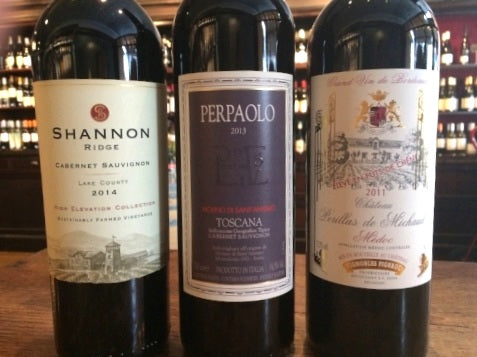Have you ever wondered why European bottles of wine will be labeled by their place of origin like "Côtes-Du-Rhône," "Chianti" or "Rioja" rather than by their respective grapes like Grenache, Sangiovese, or Tempranillo? Well, one reason is that some places have a long historical record of wine production. Another is that some wines are blends and labeling a wine "Médoc" is easier than saying Cabernet Sauvignon, Merlot, and a little Cabernet Franc. Still though, the most important reason is the idea that the expression of flavors in the wine comes from the place rather than the grape variety.
In this photo we have three wines made mostly from Cabernet Sauvignon. They are from California, Italy, and France and all have very different flavors. Of course grapes do have characteristics and we'll find some commonalities in terms of fruit character among these three; if you said dark cherry, cassis, or blackcurrant no one would argue with you. However, if we put a different grape, like a California Merlot in the mix, you'd notice that the two California wines will taste much more similar to each other rather than to their varietal counterparts from across the pond.
Why is this? Well, winemaking techniques, like using stainless steel tanks or oak barrels, indigenous or commercial yeast all play a role, but the major players here are climate and soil. The Bordeaux above comes from a much cooler climate and a shorter growing season than the Californian and Tuscan wines. The cooler climate means that the grapes won't get as ripe and the resulting wine will be more medium in body and not as forward with jammy fruit flavors as the others. Is one better than the other? No, they're different, and that's the joy in all of this.
It's useful to think of wine this way and as you move away from big generalizations you'll start to notice the nuances and subtleties in wine. Chardonnay perhaps has the widest range of styles. It can certainly make a full-bodied, buttery wine, but if you compare bottles from Chablis, Meursault, and Sonoma you'll find that they have very different personalities. You may even see that white wines grown on chalky limestone have similarities even if the grapes are different, like Chablis (Chardonnay) and Sancerre (Sauvignon Blanc). If you look at a large region in this way, like Bordeaux, you'll start to understand why it's mostly Merlot in Saint-Émilion and why Cabernet Sauvignon is dominant in Saint-Estèphe. Same goes for American Pinot Noirs, there's a general style but clear differences in wines from Santa Barbara, Carneros, or the Willamette Valley based on climate and soil types. This is the entire reason for geographical classifications on European bottles such as "Appellation Contrôlée" in France, "Denominazione Di Origine Controllata E Garantita" in Italy, and "Denominación De Origen Calificada" in Spain.
I encourage you to think "place" and not "grape" and try wines with an open mind. Learning about the wines and understanding a little background will give more enjoyment and pleasure in what you are drinking.


Five Things to Know on International Sauvignon Blanc Day
A Word About Natural Wines